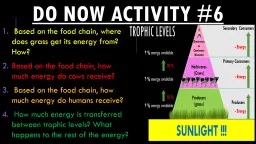/


Do now activity 6 Based on the food chain where does grass get its energy from How Based on the food chain how much energy do cows receive Based on the food chain how much energy do humans receive ID: 774137
Download Presentation The PPT/PDF document "Do now activity #6" is the property of its rightful owner. Permission is granted to download and print the materials on this web site for personal, non-commercial use only, and to display it on your personal computer provided you do not modify the materials and that you retain all copyright notices contained in the materials. By downloading content from our website, you accept the terms of this agreement.
Do now activity #6 Based on the food chain, where does grass get its energy from? How?Based on the food chain, how much energy do cows receive? Based on the food chain, how much energy do humans receive? How much energy is transferred between trophic levels? What happens to the rest of the energy?
Section 7-4: Cycles of matterEssential Question: Pick 1 Cycle of Matter. Explain how it works from beginning to end. Learning Target Create a flow map that demonstrates the movement of carbon through an ecosystem.
announcements Available Extra Credit:Starburst Original Jellybeans = 30 Points Stauffer’s Original Animal Crackers = 30 Points
Don’t forget to chunk your notes!
Cycles of matter Biological systems do not use up matter, they transform it!
Cycles of matter Matter passes from one organism to another.
Cycles of matter Four main biogeochemical cycles: The water (H2O) cycle The carbon (C) cycle The nitrogen (N) cycle The Phosphorus (P) cycle
Don’t forget to chunk your notes!
The water cycle
The water cycle Evaporation – H 2 O changes from liquid to a gas Transpiration – H 2 O that is released from plants (stomata)
The water cycle Condensation: H 2 O vapor turns into a liquid
The water cycle Precipitation – H 2 O changes from gas to a liquid (rain, snow)
Don’t forget to chunk your notes!
Atmosphere is 78% N 2 (gas) The nitrogen cycle
Bacteria has to change N 2 (gas) into nitrate so plants can use it The nitrogen cycle
When dead organisms, urine, & feces are broken down by decomposers it causes denitrification The nitrogen cycle
Don’t forget to chunk your notes!
The phosphorus cycle Phosphorus is necessary for organisms (ATP/DNA/RNA)
The phosphorus cycle Stored mostly in rocks, soil and ocean sediment.
Don’t forget to chunk your notes!
The carbon cycle
Carbon Dioxide Production: Cellular respiration Decomposers Human influence (fossil fuels) The carbon cycle
Carbon Dioxide Usage: Photosynthesis! The carbon cycle
The carbon cycle
The nutrient cycles Please complete the Cycles of Matter Worksheet. For more information, these cycles can be found in your book:Water (H2O): Page 75Carbon (C): Page 77Nitrogen (N): Page 78Phosphorous (P): Page: 79